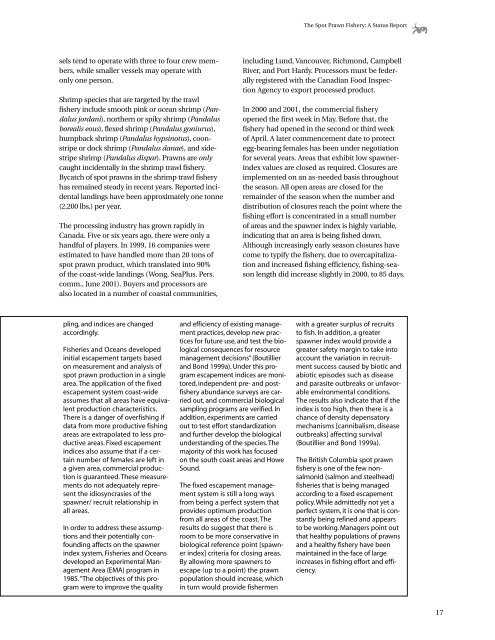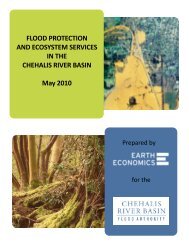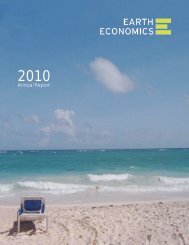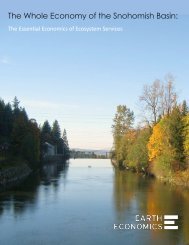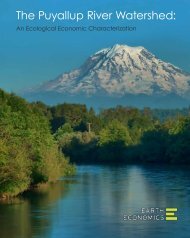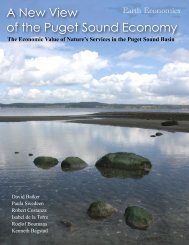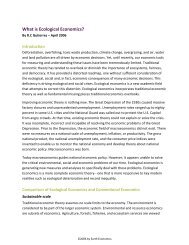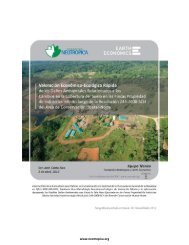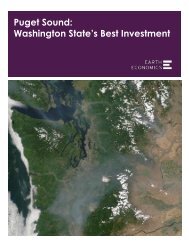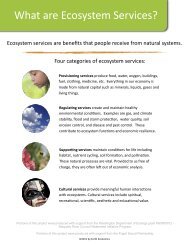The Spot Prawn Fishery: A Status Report - Earth Economics
The Spot Prawn Fishery: A Status Report - Earth Economics
The Spot Prawn Fishery: A Status Report - Earth Economics
Create successful ePaper yourself
Turn your PDF publications into a flip-book with our unique Google optimized e-Paper software.
<strong>The</strong> <strong>Spot</strong> <strong>Prawn</strong> <strong>Fishery</strong>: A <strong>Status</strong> <strong>Report</strong><br />
sels tend to operate with three to four crew members,<br />
while smaller vessels may operate with<br />
only one person.<br />
Shrimp species that are targeted by the trawl<br />
fishery include smooth pink or ocean shrimp (Pandalus<br />
jordani), northern or spiky shrimp (Pandalus<br />
borealis eous), flexed shrimp (Pandalus goniurus),<br />
humpback shrimp (Pandalus hypsinotus), coonstripe<br />
or dock shrimp (Pandalus danae), and sidestripe<br />
shrimp (Pandalus dispar). <strong>Prawn</strong>s are only<br />
caught incidentally in the shrimp trawl fishery.<br />
Bycatch of spot prawns in the shrimp trawl fishery<br />
has remained steady in recent years. <strong>Report</strong>ed incidental<br />
landings have been approximately one tonne<br />
(2,200 lbs.) per year.<br />
<strong>The</strong> processing industry has grown rapidly in<br />
Canada. Five or six years ago, there were only a<br />
handful of players. In 1999, 16 companies were<br />
estimated to have handled more than 20 tons of<br />
spot prawn product, which translated into 90%<br />
of the coast-wide landings (Wong, SeaPlus. Pers.<br />
comm., June 2001). Buyers and processors are<br />
also located in a number of coastal communities,<br />
including Lund, Vancouver, Richmond, Campbell<br />
River, and Port Hardy. Processors must be federally<br />
registered with the Canadian Food Inspection<br />
Agency to export processed product.<br />
In 2000 and 2001, the commercial fishery<br />
opened the first week in May. Before that, the<br />
fishery had opened in the second or third week<br />
of April. A later commencement date to protect<br />
egg-bearing females has been under negotiation<br />
for several years. Areas that exhibit low spawnerindex<br />
values are closed as required. Closures are<br />
implemented on an as-needed basis throughout<br />
the season. All open areas are closed for the<br />
remainder of the season when the number and<br />
distribution of closures reach the point where the<br />
fishing effort is concentrated in a small number<br />
of areas and the spawner index is highly variable,<br />
indicating that an area is being fished down.<br />
Although increasingly early season closures have<br />
come to typify the fishery, due to overcapitalization<br />
and increased fishing efficiency, fishing-season<br />
length did increase slightly in 2000, to 85 days.<br />
pling, and indices are changed<br />
accordingly.<br />
Fisheries and Oceans developed<br />
initial escapement targets based<br />
on measurement and analysis of<br />
spot prawn production in a single<br />
area. <strong>The</strong> application of the fixed<br />
escapement system coast-wide<br />
assumes that all areas have equivalent<br />
production characteristics.<br />
<strong>The</strong>re is a danger of overfishing if<br />
data from more productive fishing<br />
areas are extrapolated to less productive<br />
areas. Fixed escapement<br />
indices also assume that if a certain<br />
number of females are left in<br />
a given area, commercial production<br />
is guaranteed. <strong>The</strong>se measurements<br />
do not adequately represent<br />
the idiosyncrasies of the<br />
spawner/ recruit relationship in<br />
all areas.<br />
In order to address these assumptions<br />
and their potentially confounding<br />
affects on the spawner<br />
index system, Fisheries and Oceans<br />
developed an Experimental Management<br />
Area (EMA) program in<br />
1985.“<strong>The</strong> objectives of this program<br />
were to improve the quality<br />
and efficiency of existing management<br />
practices, develop new practices<br />
for future use, and test the biological<br />
consequences for resource<br />
management decisions” (Boutillier<br />
and Bond 1999a). Under this program<br />
escapement indices are monitored,<br />
independent pre- and postfishery<br />
abundance surveys are carried<br />
out, and commercial biological<br />
sampling programs are verified. In<br />
addition, experiments are carried<br />
out to test effort standardization<br />
and further develop the biological<br />
understanding of the species.<strong>The</strong><br />
majority of this work has focused<br />
on the south coast areas and Howe<br />
Sound.<br />
<strong>The</strong> fixed escapement management<br />
system is still a long ways<br />
from being a perfect system that<br />
provides optimum production<br />
from all areas of the coast. <strong>The</strong><br />
results do suggest that there is<br />
room to be more conservative in<br />
biological reference point [spawner<br />
index] criteria for closing areas.<br />
By allowing more spawners to<br />
escape (up to a point) the prawn<br />
population should increase, which<br />
in turn would provide fishermen<br />
with a greater surplus of recruits<br />
to fish. In addition, a greater<br />
spawner index would provide a<br />
greater safety margin to take into<br />
account the variation in recruitment<br />
success caused by biotic and<br />
abiotic episodes such as disease<br />
and parasite outbreaks or unfavorable<br />
environmental conditions.<br />
<strong>The</strong> results also indicate that if the<br />
index is too high, then there is a<br />
chance of density depensatory<br />
mechanisms [cannibalism, disease<br />
outbreaks] affecting survival<br />
(Boutillier and Bond 1999a).<br />
<strong>The</strong> British Columbia spot prawn<br />
fishery is one of the few nonsalmonid<br />
(salmon and steelhead)<br />
fisheries that is being managed<br />
according to a fixed escapement<br />
policy. While admittedly not yet a<br />
perfect system, it is one that is constantly<br />
being refined and appears<br />
to be working. Managers point out<br />
that healthy populations of prawns<br />
and a healthy fishery have been<br />
maintained in the face of large<br />
increases in fishing effort and efficiency.<br />
17


